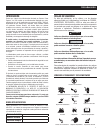
20
Contact with muffler area can result in serious
burns. Exhaust heat/gases can ignite
combustibles, structures or damage fuel tank
causing a fire.
• DO NOT touch hot parts and AVOID hot exhaust gases.
• Allow equipment to cool before touching.
• Keep at least 5 feet (152 cm) of clearance on all sides of the power
washer including overhead.
• It is a violation of California Public Resource Code, Section 4442,
to use or operate the engine on any forest-covered, brush-covered,
or grass-covered land unless the exhaust system is equipped with
a spark arrester, as defined in Section 4442, maintained in effective
working order. Other states or federal jurisdictions may have similar
laws.
Contact the original equipment manufacturer, retailer, or dealer to
obtain a spark arrester designed for the exhaust system installed
on this engine.
• Replacement parts must be the same and installed in the same
position as the original parts.
AFTER EACH USE
Water should not remain in the unit for long periods of time.
Sediments or minerals can deposit on pump parts and freeze pump
action. Follow these procedures after every use:
1. Shut off the engine, turn off the water supply, point the gun
in a safe direction, and squeeze the trigger to relieve trapped
pressure, and let the engine cool.
The high pressure stream of water that this equipment
produces can cut through skin and its underlying
tissues, leading to serious injury, possible amputation
or death. Spray gun traps high water pressure, even
when engine is stopped and water is disconnected,
which can cause injury.
• Keep the high pressure hose connected to the pump and spray gun
while the system is pressurized.
• ALWAYS point the spray gun in a safe direction, and squeeze the
spray gun trigger to release high pressure every time you stop the
engine. Engage the trigger lock when not in use.
2. Disconnect the hoses from the spray gun and high pressure
outlet on the pump. Drain water from the hoses, spray gun,
and lance. Use a rag to wipe off the hose.
3. Empty the pump of all pumped liquids. Check that the engine
ON/OFF switch and fuel valve are in the OFF position. Then pull
the recoil handle about six times. This should remove most of
the liquid in the pump.
4. Store the unit in a clean, dry area.
5. If storing for more than 30 days, see the Long Term Storage
section.
Fuel and its vapors are extremely flammable
and explosive. Fire or explosion can cause
severe burns or death.
WHEN STORING FUEL OR EQUIPMENT WITH FUEL IN TANK:
• Store away from furnaces, stoves, water heaters, clothes dryers,
or other appliances that have a pilot light or other ignition source
because they can ignite fuel vapors.
WINTER STORAGE
NOTE:
You must protect the unit from freezing temperatures.
• Failure to do so will permanently damage the pump and render the
unit inoperable.
• Freeze damage is not covered under the warranty.
To protect the unit from freezing temperatures:
1. Follow steps 1-3 in the previous section, After Each Use.
2. Use a pump saver to treat pump. This minimizes freeze
damage and lubricates the pistons and seals.
3. If a pump saver is not available, connect a 3-foot section of
garden hose to the water inlet adapter. Pour RV-antifreeze
(antifreeze without alcohol) into the hose. Pull the recoil handle
twice. Disconnect the 3-foot hose.
4. Store the unit in a clean, dry area.
LONG TERM STORAGE
If you do not plan to use the power washer for more than 30 days,
you must prepare the engine and pump for long term storage.
PROTECT FUEL SYSTEM
Fuel can become stale when stored for over 30 days. Stale
fuel causes acid and gum deposits to form in the fuel system
or on essential carburetor parts. To keep the fuel fresh, use a
fuel stabilizer, available as a liquid additive or a drip concentrate
cartridge.
There is no need to drain the gasoline from the engine if a fuel
stabilizer is added according to instructions. Run the engine for
2 minutes to circulate the stabilizer throughout the fuel system.
The engine and fuel can then be stored up to 24 months (per fuel
stabilizer manufacturer's specifications).
If the gasoline in the engine has not been treated with a fuel
stabilizer, it must be drained into an approved container. Run the
engine until it stops from lack of fuel. The use of a fuel stabilizer
in the storage container is recommended to maintain freshness.
CHANGE OIL
While the engine is still warm, drain the oil from crankcase. Refill
with the recommended grade. See Changing Engine Oil in Engine
Maintenance.
Maintenance


















